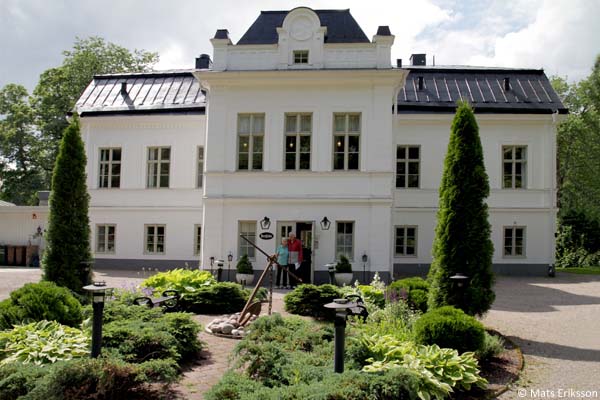Älvkarleö mill and mansion
|
Drawings of the houses and garden during different time periods
Älvkarleö mill was when it was laid out in 1659, the first ironworks at lower Dalälven. It was the former mining assessor in Stora Kopparberg, Claes Depken who took the initiative. The conditions for mill operation in this region with its abundant water power and good forest access were favorable. Depken therefore requested royal permission to build a blast furnace and forging hammer at Älvkarleby waterfalls, but the authorities declared that no mills could be built there because the fishing of salmon could not be disturbed. Depken was instead assigned a building site for the new mill at Drakestens stream at Öhn, as the place was called at that time. Now an intensive construction was undertaken. The first hammer mill was built in 1699 next to Dalälvens mainstream, but this place was less suitable which was why the forge after a couple of years had to be moved downstream to a spot about 300 meters above the mansion's garden. There was also built a blast furnace on the island where the mansion's garden was and a sawmill on a smaller islet further up the river. A few years later another smithy was built about midway between the mansion and the office. Mill operation continued ever since its inception until 1971, but the effects varied according to interests and business cycles. Crucible Steel production was started in 1768. This production lasted until 1886. Crucible steel was used for drills, files and the like, and in the 1880's was rolled at Söderfors to spring steel. For the Söderfors Company built in 1887 a steam sawmill on the so-called Sågholmer between the mansion and the office. It was equipped with such modern conveniences as electric lighting and tramway. The sawmill was shut down in 1907. Such a differentiated product offering could not be maintained with profitability and manufacture of the products ceased gradually. About the mansion's architectural history we know very little. A first mansion was built, however, probably associated with the mill's inception. On the first map of the mill from 1697 a farm is marked as a collection of buildings in the closed square in the place where the mansion now stands. Here lived Depken and led the establishment and management of the three mills Älfkarleö, Härnäs and Hyttön. He soon had other things to think about. War between Sweden and Denmark erupted and in the Swedish navy it was found that several of the ships lacked anchors. Depken then developed at Älvkarleö a brand new method of anchor manufacturing, which worked so well that he was commissioned to build a special anchor mill, for which he was knighted with the name Anckarström. This was the origin of Söderfors mill, erected in 1676.From Anckarström's time is told that King Karl XI once made a visit. The king who had ridden from Örbyhus arrived in the early morning at Älvkarleö. He did not want to wake the ironmaster at so early a time and sat down on a bench at the mansion. For the mill facilities in Älvkarleby parish Depken had, however, three merchants as stakeholders. Three Leijel brothers, who in the late 1630s had moved to Sweden from Scotland. It now became these who took the first administration and then the ownership of the three mills. The mansion at Älvkarleö was left in wife Ehrencrona's possession until 1704 when it was sold to Mrs. Anna Helena Leijel. After her death, the farm slowly decayed. The farm-house then included the big house with 11 rooms, two cellars and an attic room. Älvkarleö mill was held by the family Leijel until 1772 and the mansion was inhabited by various members of this family. The administration was exercised, however, from the office building known today as Bruksgården, also "Petter Leijels farm" originally built in 1697, later a few times completely rebuilt, most recently in 1897. About the Leijelska era also reminds one of Älvkarleby church's most precious ornaments, a picture painted in 1563 by the Dutch master Joakim Buecklaer. In 1772 Älvkarleö mill came to be owned by the Tottieska family. In 1845 Älvkarleö mill was sold to Per Adolf Tamm at Österby and wholesaler Carl Ostberg. During this shift, there was a conversion and extension of the manor, which then was supplied with the two front pieces on the front and rear sides. A noble park with manicured gravel paths was built simultaneously in front of the building. Then followed for the manor a rental period. First tenant was Baron Claes Arvid Brother Cederstrom from Malmö who lived here from 1874 to 1878. He was followed by the former owner of Hammarby mill in Gästrikland, Knut Casimir Petre, 1880-1887 . After that, the mansion became the seat of Söderfors company's managing director. One half of the office building became the company's headquarters, the other half was customary office. As the company 's managing manager Per Gustaf Tamm returned to the mansion. He also lived at Söderfors, and it is told of four horses shiny and sleek wagons which in record time did the distance between the two mills. PG Tamm however, had many strings to his bow. As a member of the parliamentary upper house, member of the banking and mortgage and railway boards and councils in Jernkontoret he could only for short periods of time have been able to enjoy his two historic mansions. Stora Kopparberg Bergslagen AB acquired in 1907 Söderfors Company's shares, whereby Älvkarleö mill became a part of Stora Kopparberg Bergslagen AB. After a thorough restoration the farm was given from the summer of 1952 a new role to play. Disposition Court handed over the set period for the Association of Swedish Lottakårer, SLK, as training center. In 1967 the mansion was sold to SLK. Besides National Association own courses and conferences, it is available for other organizations, businesses and individuals. Source: Svenska Lottakårers information leaflet about Älvkarleö mansion Link: Älvkarleö mansion
|







